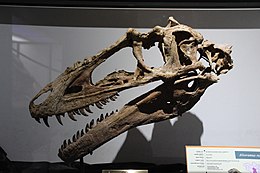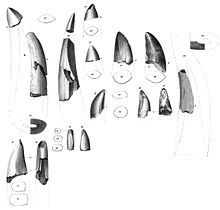Tyrannosaurinae
| Tyrannosaurinae | |
|---|---|

| |
| Skull of Alioramus. | |

| |
| Skull of Tyrannosaurus. | |
| Scientific classification | |
| Domain: | Eukaryota |
| Kingdom: | Animalia |
| Phylum: | Chordata |
| Clade: | Dinosauria |
| Clade: | Saurischia |
| Clade: | Theropoda |
| Family: | †Tyrannosauridae |
| Subfamily: | †Tyrannosaurinae Osborn, 1906 |
| Type genus | |
| †Tyrannosaurus Osborn, 1905
| |
| Subgroups[2] | |
| |
Tyrannosaurinae (sometimes referred to as tyrannosaurines) is one of the two extinct subfamilies of
History of discovery

The first remains of tyrannosaurids were uncovered during expeditions led by the
The second described representative of the tyrannosaurines,
In the 1970s saw the description of two genera. In 1970 saw the publication of
From 1977 to 2009 saw the publications of several genera. In Asia they include Shanshanosaurus (1977),[10] Maleevosaurus (1992),[11] and Raptorex (2009),[12] while in North America saw Nanotyrannus (1988),[13] Dinotyrannus and Stygivenator (1995).[14] These genera, however are controversial as the remains of these animals are immature or juvenile individuals. As of 2021 it is widely understood that the Asian specimens are early growth stages of Tarbosaurus,[15][16][17] while the North American specimens are those of Tyrannosaurus.[18][19]

Valid genera would not be named until the 2010s, where in 2011 announced the publication of
Natural history
Description


In comparison to the albertosaurines, tyrannosaurines were more heavily built and larger. The alioramin genera of Qianzhousaurus and Alioramus, however, were the exception, as they were more comparable in built to albertosaurines and have longirostrine snouts.[24] Like albertosaurines, tyrannosaurines also had heterodont dentition, large heads design to catch and kill their prey, and short didactyl arms. Based on the growth stages of Tyrannosaurus (and possibly Tarbosaurus[17]), tyrannosaurines undergone ontogenetic changes from gracile or slender, semi-longirostrine immatures to robust, heavy-headed adults. This implies that these animals occupy different ecological niches as they developed.[19] While there is fossil evidence of earlier tyrannosauroids having feathers,[26][27] the evidence of such structures in tyrannosaurids is controversial as a study in 2017 from Bell and colleagues found no support in feathered integument in tyrannosaurids.[28] The study used skin impressions which are small, found widely dispersed across the post-cranium at different regions of the body with a pattern similar to crocodiles. Further the croc analogy Thomas Carr and colleagues in 2017 by studying the snout of Daspletosaurus suggested they have large scales with sensory sensory neuron pits under the skin.[29] This notion has been challenged from other authors who suggested a more lip-covering of the teeth.[30]
Distribution
The temporal range for tyrannosaurines went from almost 80.6 million years ago in the Campanian stage of the Late Cretaceous epoch to 66 million years ago in the Maastrichtian stage. Fossils have been found in different formations in what is now east Asia and western North America. While the Asian alioramins are the basal most group of the tyrannosaurines, the geographic placement of albertosaurines and other eutyrannosaurian tyrannosauroids found in North America suggests greatly the tyrannosaurines are North American in origin.[31]
Systematics
Prior to the 2010s, the relationships of the tyrannosaurines was best understood as Tyrannosaurus being a sister taxon to Tarbosaurus. These two genera in turn were the sister taxon to Daspletosaurus, follow by Alioramus. There was an alternative hypothesis from
The
| Eutyrannosauria |
| |||||||||||||||||||||||||||||||||
As of 2023, at least three lineages of tyrannosaurines have been suggested.[33] The basalmost clade is the Alioramini. The second clade to diverge is the Teratophoneini, which comprises the American southwest taxa Dynamoterror, Lythronax, and Teratophoneus. They are sister to a third clade comprising Nanuqsaurus and the clade containing Daspletosaurini, which includes Daspletosaurus and Thanatotheristes, and the Tyrannosaurini, which includes Zhuchengtyrannus, Tarbosaurus, and Tyrannosaurus.[1]
The cladogram below displays the results of the strict consensus phylogenetic analysis performed by Scherer & Voiculescu-Holvad (2023), indicating the distinct lineages of tyrannosaurines.[1]
| Tyrannosaurinae |
| ||||||||||||||||||||||||||||||||||||||||||||||||||||||||||||||||||||||||||||||||||||
References
- ^ ISSN 0195-6671.
- ^ Holtz, Thomas R. Jr. (2012) Dinosaurs: The Most Complete, Up-to-Date Encyclopedia for Dinosaur Lovers of All Ages, Winter 2011 Appendix. Archived 2017-08-12 at the Wayback Machine
- ^ Breithaupt, B.H.; Southwell, E.H.; Matthews, N.A. (18 October 2005). "In Celebration of 100 years of Tyrannosaurus rex: Manospondylus gigas, Ornithomimus grandis, and Dynamosaurus imperiosus, the Earliest Discoveries of Tyrannosaurus rex in the West". Abstracts with Programs. 2005 Salt Lake City Annual Meeting. Vol. 37. Geological Society of America. p. 406. Archived from the original on 22 October 2019. Retrieved 8 October 2008.
- ^ Breithaup, BH; Southwell EH; Matthews NA (2006). "Dynamosaurus imperiosus and the earliest discoveries of Tyrannosaurus rex in Wyoming and the West". New Mexico Museum of Natural History and Science Bulletin. 35: 257–258.
- Doklady Akademii Nauk SSSR. 104 (4): 634–637.
- Doklady Akademii Nauk SSSR. 104 (5). translated by F. J. Alcock: 779–783.
- ^ Rozhdestvensky, Anatoly K. (1965). "Growth changes in Asian dinosaurs and some problems of their taxonomy". Paleontological Journal. 3: 95–109.
- ^ Russell, Dale A. (1970). "Tyrannosaurs from the Late Cretaceous of western Canada". National Museum of Natural Sciences Publications in Paleontology. 1: 1–34.
- ^ Kurzanov, Sergei M. "A new carnosaur from the Late Cretaceous of Nogon-Tsav, Mongolia". The Joint Soviet-Mongolian Paleontological Expedition Transactions (in Russian). 3: 93–104.
- ^ Dong Zhiming (1977). "On the dinosaurian remains from Turpan, Xinjiang". Vertebrata PalAsiatica (in Chinese). 15: 59–66.
- ^ Carpenter, Ken. (1992). "Tyrannosaurids (Dinosauria) of Asia and North America". In Mateer, Niall J.; Peiji, Chen (eds.). Aspects of Nonmarine Cretaceous Geology. Beijing: China Ocean Press. pp. 250–268.
- S2CID 1953405.
- ^ Bakker, R.T.; Williams, M.; Currie, P.J. (1988). "Nanotyrannus, a new genus of pygmy tyrannosaur, from the latest Cretaceous of Montana". Hunteria. 1: 1–30.
- ^ Olshevsky, G. (1995). "The origin and evolution of the tyrannosaurids". Kyoryugaku Saizensen [Dino Frontline]. 9–10: 92–119.
- S2CID 83744433.
- .
- ^ PMID 21738646.
- PMID 31911944.
- ^ .
- ^ S2CID 13261338.
- .
- ^ PMID 24621577.
- S2CID 130766946.
- ^ PMID 24807588.
- ^ PMID 24223179.
- S2CID 4381777.
- S2CID 29689629. Archived from the original(PDF) on 17 April 2012.
- PMID 28592520.
- PMID 28358353.
- S2CID 6859452.
- ^ S2CID 133830150.
- Currie, Philip J.; Hurum, Jørn H.; Sabath, Karol (2003). "Skull structure and evolution in tyrannosaurid phylogeny" (PDF). Acta Palaeontologica Polonica. 48 (2): 227–234. Archived from the original(PDF) on October 25, 2007.
- ^ S2CID 213838772.
- ISBN 978-0-671-61946-6.
- ISBN 9781400883141.
